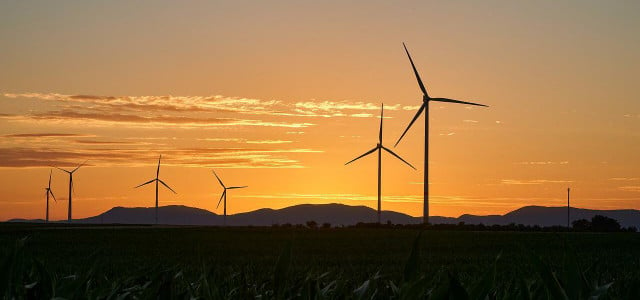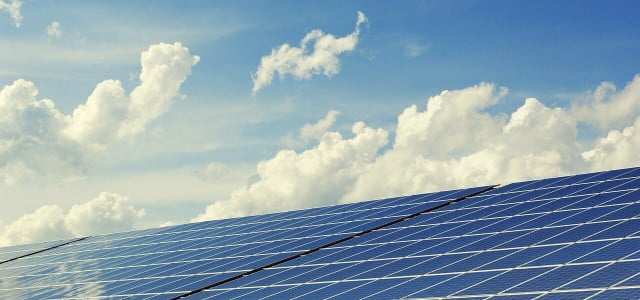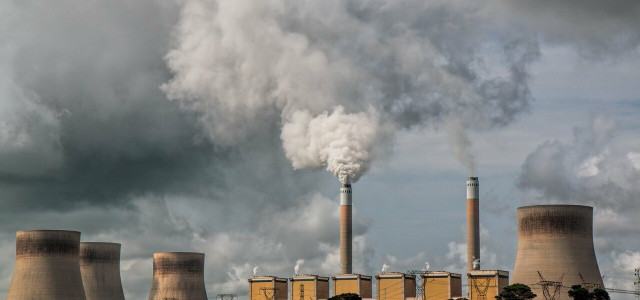There are many types of renewable energy, but understanding the differences can be complicated. Here, we clear up what they are, how they differ and why they’re so important.
Renewable energy simply refers to an energy source that doesn’t run out. Traditional energy sources, such as coal or oil, are non-renewable, meaning they are finite and we will one day use up the earth’s supply.
This is obviously an issue, as the entire infrastructure of our planet currently revolves around humans using vast quantities of these substances, which take thousands, or in some cases, millions of years to reproduce. Coal, natural gas and petroleum are formed from the buried remains of ancient sea plants and animals, which is why they’re often called fossil fuels.
Why We Need To Move Away From Non-renewable Energy — Fast
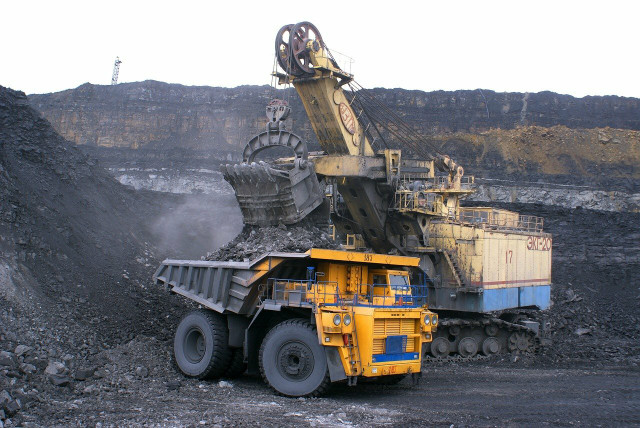
The US (as well as much of the world) currently uses the following forms of non-renewable energy:
- Petroleum
- Hydrocarbon gas liquids
- Natural gas
- Coal
- Nuclear energy
However, there are several important reasons we need to change where we get our energy from.
Land destruction
Sea beds are plowed, mountains are literally moved, and habitats are annihilated in order for us to gain access to oil, gas, coal, and uranium deposits.
Water pollution
Coal mining operations often leak rock, soil, and toxic chemicals into the earth and groundwater. Oil spills pollute our oceans, killing marine life and permanently damaging entire ecosystems. Our drinking water can also be polluted to the extent that there is a provable cause and effect between areas close to hydraulic fracturing sites and cases of cancer, birth defects and neurological damage.
Air emissions
Even before they’re used, extracted fossil fuels pollute our air, causing a wide array of issues for humans and wildlife. Indeed, some 17.6 million Americans are potentially exposed to toxic air pollution by living within a mile of oil and gas wells. Benzine, which causes childhood leukemia and blood disorders, and formaldehyde, which causes cancer, are just two of these toxins. Fracking, a growing industry in the US, is linked to several serious health problems.
Accelerated global warming
Perhaps most alarming of all, the burning of fossil fuels is a lead cause of carbon emissions, which accelerates global warming (climate change). This occurs as carbon emissions trap heat in the atmosphere, leading to the warming of the climate — with disastrous consequences.
So, it’s urgent that we rethink where we get our energy from. The survival of our planet depends on harnessing clean, renewable energy sources.
1. Solar Power
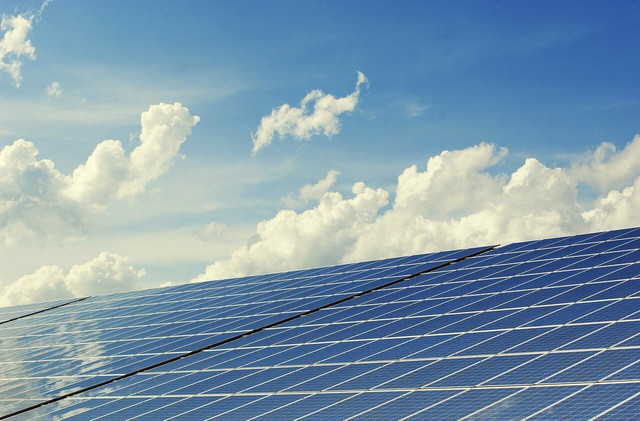


Solar energy is energy from the sun. It can be converted into clean thermal and electrical energy that generates electricity, heating, and hot water. Currently, only around 3% of US electricity comes from solar energy. However, its potential is enormous — panels covering roughly the size of Lake Michigan (around 22,000 square miles) could power the entire United States.
Types of solar power
There are three primary technologies used to harness solar energy:
- Photovoltaics: Light is converted directly to electricity.
- Concentrating solar power: The sun’s heat (thermal energy) is used to drive utility-scale electric turbines.
- Solar heating and cooling systems: Thermal energy is used to heat water and air.
Advantages of solar power
Generally speaking, the advantages of solar power vastly outweigh the disadvantages. For instance, solar power is a clean and cheap energy source that produces no toxic or polluting chemicals into the air. It is widely available (although we will come to this below) and even stimulates local economies and creates green employment.
When used effectively, it also doesn’t take up too much space. Compared to other types of renewable energy, it is suitable for use in cities and urban areas (panels can be put on top of buildings, for example).
Disadvantages of solar power
Unfortunately, some places on earth are simply sunnier than others and, therefore, more viable as generators for solar energy. For example, California would have better access to solar power than Michigan. While the sun is a constant presence, unpredictable weather patterns can impact the strength and regularity of solar power.
Also, while prices are falling rapidly (and government subsidies are available), the high initial startup cost of solar panels acts as a disincentive for many households. However, many prominent voices in the field would argue strongly that real change will be possible once the financial burden and moral onus of transitioning to green energy are on the world’s governments rather than the individual.
2. Wind Energy
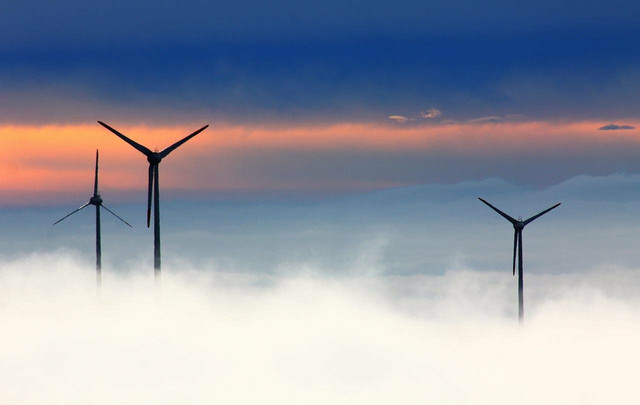


Also known as wind power, this form of energy comes from wind generating mechanical power. Generators convert this mechanical power into electricity. The mechanical power can also be used more directly, such as for grinding grain or pumping water.
Wind turbines
The most common way of harvesting wind energy is via wind turbines, which you have most likely seen dotted across the US in increasing numbers over the past few decades. These turbines work by aerodynamic forces spinning the rotor blades, which are connected to a gearbox and then fed into a generator. This translation of aerodynamic force into the rotation of a generator creates electricity.
Wind turbines are the most identifiable symbol of renewable energy for many people. Extensive debates have taken place about whether they’re an icon of progress or an eyesore.
Advantages of wind energy
The main advantages of wind power include that it’s an unlimited, free, renewable resource. It’s an economical form of energy both in terms of maintenance and for the consumer. Wind power plants can also be located offshore — offshore wind farms produce more energy than inshore due to the stronger wind out at sea.
Of course, unlike traditional power plants, wind power emits no air pollutants or greenhouse gases.
Disadvantages of wind energy
While the energy is clean and cheap, constructing turbines and wind facilities is extremely expensive. The manufacturing and engineering cost of putting enormous wind turbines out at sea is costly, complicated, and time-consuming.
As we mentioned earlier, many people are concerned with the visual effects that wind turbines have on the natural scenery. Many wind farms are placed in remote areas of nature, previously unspoiled. Likewise, some wind farms produce noise that is offputting to local communities.
Wind turbines may also put some wildlife at risk of harm. Many birds and bats have been killed by flying into the rotors, and experts are only now researching wind turbines’ effects on marine habitats.
3. Hydro Energy
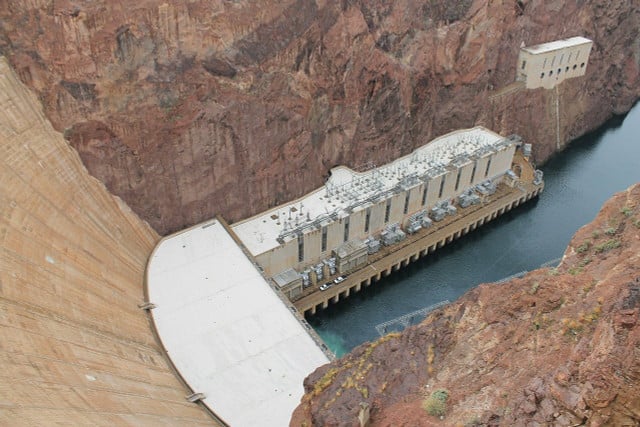


Hydropower is actually one of the world’s oldest forms of energy. It’s derived from the pressure from flowing water powering turbines, such as modern-day dams or pre-industrial watermills.
It remains an important energy source today, representing 37% of the US’s renewable electricity generation and about 7% of the total electricity generation.
History of hydro energy
Humans have utilized hydro energy for thousands of years. Some of the first innovations (that we know about) began in China between 2 BC and 9 AD in the form of water wheels used for pounding grain and breaking ore and early paper-making. A little later, on the other side of the world, the Greeks also developed water wheels to grind wheat — more than 2,000 years ago.
The modern hydropower turbine was developed from the ideas laid out in a four-volume set of books called Architecture Hydraulique by military engineer Bernard Forest de Bélidor, written in France in the mid-1700s. These works outlined the principles essential for developing the turbines that went on to convert kinetic energy from water into electricity used to power — for example, lights.
In fact, the world’s first hydroelectric project was used to power a single lamp in the Cragside country house in Northumberland, England, in 1878. Four years later, the first hydroelectric power plant opened its doors in Wisconsin — within a decade, hundreds were in operation across the country.
Advantages of hydro energy
Hydroelectric power is a domestic energy source, meaning each state or local area can be left in charge of producing its own energy. Once in place, it’s also cheap to run, meaning cheaper gas bills for the consumer.
Energy aside, impoundment hydropower requires the creation of reservoirs that often provide local opportunities for sustainable recreation, such as swimming and boating. These interventions can also supply flood control, irrigation support, and clean drinking water for large population centers.
Disadvantages of hydro energy
Conversely, such interventions can also cause significant environmental damage. Wildlife habitats are often uprooted or destroyed to create dams and impeded fish migration is a common issue, both serious blemishes on the reputation of hydro energy.
Human communities and cultures are also directly affected. Social issues from the removal or disruption of rivers can drastically affect indigenous communities and population centers that rely on rivers by disrupting their water source.
Some scientists even argue that these disadvantages mean hydro energy is not sustainable at all.
4. Tidal Energy
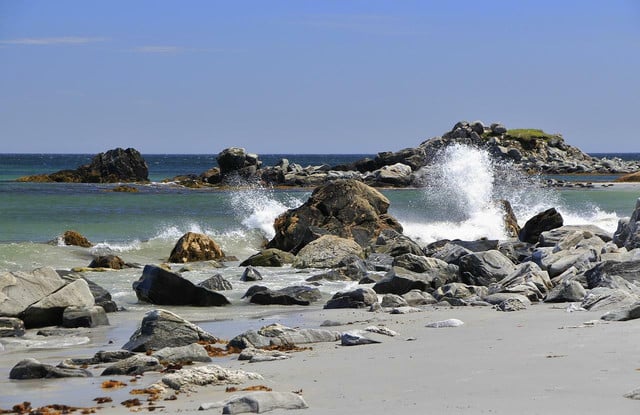


Unlike hydro energy, which relies on the pressure from predominantly in-land flowing water bodies, tidal energy is power produced by the surge of ocean waters during the rise and fall of tides. Like wind energy, these surges power a turbine connected to a gearbox that turns a generator, creating electricity.
Future of tidal energy
Tidal energy is still a relatively new energy source, and this method has not yet produced much power. However, researchers are now recognizing the vast potential of the ocean to produce reliable, renewable, clean energy, with the potential to generate enough electricity to power millions of homes across the world.
Advantages of tidal energy
Because water is so much denser than air, tidal energy is vastly more powerful than solar and wind energy. It can produce exponentially more power at the same turbine diameter and rotor speed while also being more predictable. So, imagine all the benefits of solar and wind (e.g., clean, cheap energy), but without the disadvantage of intermittent power. This makes tidal energy an attractive renewable energy source to pursue.
Disadvantages of tidal energy
As tidal energy is still in its developmental infancy, cost is a massive strike against this type of renewable energy. The initial development, followed by connecting everything to power grids, requires plenty of expensive engineering and manufacturing work. This significantly impacts the time it takes to kick-start projects, which puts off investors. Thus, an investment tailspin occurs, making it hard to get tidal energy plants started.
Aside from investment issues, tidal energy also has the potential to negatively affect the environment. Turbines must be placed under the sea, likely affecting sea life and their habitats. Rotating turbine blades could catch marine life and affect marine animal navigation and communication with underwater noise pollution.
5. Geothermal Energy
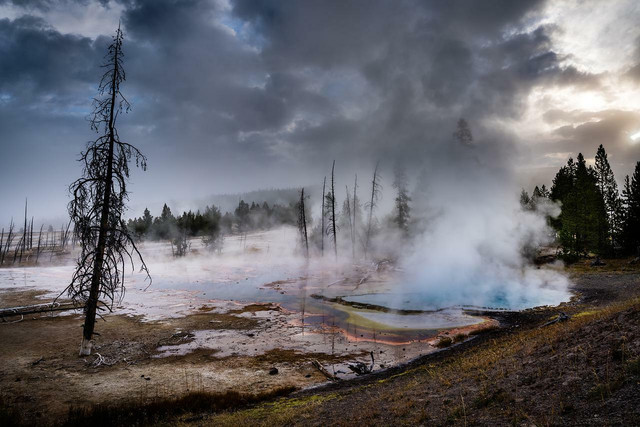


Geothermal energy is heat that comes from under the earth’s crust. Caused by the radioactive decay of particles, the earth’s core is believed to be about 10,800 °F — as hot as the surface of the sun.
Volcanoes and geysers, like the one pictured at Yellowstone National Park, are great examples of what it looks like when geothermal energy reaches the earth’s surface. This heat can then be carried from the crust by channels of water or steam and turned into energy to be harnessed.
This powerful energy source produces vast amounts of electricity in countries with large geothermal reserves. Think El Salvador, New Zealand, Kenya, the Philippines and Iceland, where geothermal energy covers over 90% of the heating demand.
Uses of geothermal energy
Geothermal energy use can be divided into three categories:
- Direct-use applications: The direct use of hot water from the source without specialized equipment, such as swimming pools, spas, and bath towns.
- Geothermal heat pumps: A system of heat exchanger (a loop of pipes buried in the ground) and a pump that can cool buildings in summer and heat them in winter.
- Electric power generation: Geothermal power plants that use steam to generate electricity.
Advantages of geothermal energy
The main advantage of geothermal power is that it doesn’t depend on unpredictable factors such as weather conditions. The earth’s core temperature is stable and, when utilized properly, can wield power of an unimaginable scale. The available geothermal energy capacity actually exceeds the 15 terawatt worldwide energy consumption.
Disadvantages of geothermal energy
The most significant disadvantage of geothermal energy is that it is location-dependent. Geothermal plants need to be built where the energy is accessible via a water or steam source. Unfortunately, this means that some parts of the earth cannot harness this resource.
Also, as with the other types of renewable energy, cost and manpower are issues. Even though there is a continuous source of heat within the earth, the energy required to extract it can be enormous. The extraction rate of the heated fluids and steam can exceed the replenishment rate, making it less worth the time and cost spent and, in turn, less sustainable.
6. Biomass Energy



Biomass is renewable, organic material that comes from plants and animals. Biomass can be burned directly for heat or converted to renewable liquid and gas.
Biomass was the primary source of U.S. energy consumption until the mid-1800s when the industrial revolution saw the introduction of non-renewable energy sources. However, many countries still use biomass energy as a leading fuel source, particularly where cooking and heating are concerned.
Sources of biomass energy
Biomass sources of energy include:
- Wood and wood processing wastes: This includes firewood, lumber, and furniture mill waste as well as black liquor from pulp and paper mills.
- Crops and waste materials: The materials and husks from farming corn, soybeans, sugar cane and crop and food processing waste.
- Biogenic materials in municipal solid waste: This could be from paper, cotton and wool products.
- Animal manure and human sewage for producing biogas/renewable natural gas
Advantages of biomass energy
Biomass energy is among the most versatile type of renewable energy around. It can be converted to create biodiesel for vehicles, methane gas, and a range of other biofuels, heat homes, and generate electricity. Also, biomass fuels can be found everywhere. There are sources of biomass energy practically everywhere on earth.
A considerable advantage is that unlike other types of renewable energy — and indeed, non-renewable energy — the costs involved in collecting biomass fuels are extremely low. In turn, this makes biomass energy more tempting for producers and investors, as they can break even from their initial investment faster.
Furthermore, much of our biodegradable waste could be used more efficiently to create biomass energy. Therefore, it’s a two-pronged force of sustainability — creating renewable energy and using waste that would otherwise sit and rot in landfills.
Disadvantages of biomass energy
The key difference between this and other renewable energy sources like the sun and water is that biomass energy requires constant maintenance. While plant life is abundant, harnessing biomass energy requires efforts to replenish and maintain stocks via regular watering, for example, and dealing with potential waste materials from overproduction (albeit these will be organic). This ultimately damages the sustainability credentials of biomass energy.
Also, frustratingly, the energy produced from biomass is not completely clean. Burning wood and other plant life creates emissions other than carbon. These can cause pollution, albeit not in as extreme or damaging ways as non-renewable energy sources. Some organizations, such as the Partnership for Policy Integration, point to biomass fuels as a form of air pollution.
Final Thoughts
To conclude, there’s no such thing as a perfect energy source. However, focusing on the often surmountable disadvantages of renewable energy sources can place us farther back in the race to tackle climate change.
Personal responsibility is a significant factor in tackling the energy crisis. Afterall, our reliance on fossil fuels largely got us here in the first place. But, to make the sizeable, urgent changes that are so badly needed, there are other ways everyday people can ensure our climate is protected.
Put pressure on local governments, make financial investment (where possible) and support research into improving sustainable alternatives. These measures are vital for targeting the largest players, and offenders, in the fight to save our planet.
Read more:
- Environmental Organizations: 8 NGOs and Non-Profits Worth Supporting
- The 16 Best Movies & Documentaries About Sustainability & the Environment
- Social Sustainability in 2022: Everything You Need to Know
Do you like this post?






